Are we in the midst of a business aviation maintenance shortage?
The answer is a resounding “yes,” according to 89 percent of business aviation maintenance leaders surveyed by Aviation Personnel International (API).
Of the 45 respondents we surveyed, 55 percent of them have lost one or more maintenance professionals in the past year.
In fact, from our survey data, a total of 43 maintenance professionals have left 24 different organizations.
The 43 who left their departments in the past year cited the following reasons:
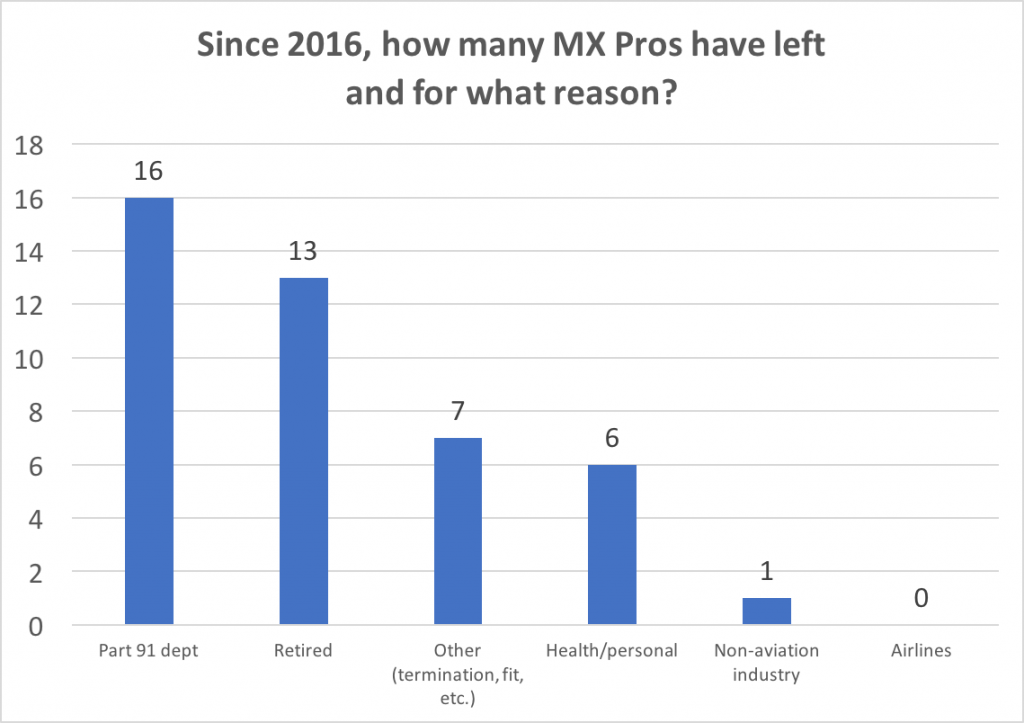
- 16 left for another flight department
- 13 retired
- 7 left for “other reasons” (e.g., performance issues)
- 6 left due to personal or health reasons
- 1 left for a non-aviation industry
If one or more employees left, they often cited one or more reasons.
“Schedule” and “career growth” were tied as reasons why an employee left the organization.
The number three reason was related to “compensation,” followed by “location” and “career stability.” A few responses in the “other” category are related to termination.
Survey Says . . .
The maintenance study was completed after our pilot talent shortage survey proved so popular with aviation industry professionals. Participants included mostly Directors of Maintenance or Chiefs of Maintenance from U.S.-based Part 91 flight departments of all sizes.
However, unlike the pilot shortage, we cannot point to the airlines as a primary source of the aviation maintenance shortage. Instead of being lured by the competing Part 121 industry to make more money (as pilots are), aircraft mechanics are focused on retirement, leaving departments with longer-tenured shoes to fill.
When we asked about the average tenure of maintenance pros within each flight departments, many cited an average of 20-30 years. This means several organizations are “top-heavy,” with longer tenured mechanics remaining in their roles.
With fewer students entering technical schools, the talent gap isn’t going away any time soon. According to one respondent, “The shortage will greatly affect us as we have four senior flight engineers who are retiring in five years.”
The talent gap is real, and an issue for this maintenance director:
“Qualified individuals can only be obtained by removing them from existing, high-level peer organizations.”
Just what skills are we talking about? All kinds—from inspection, avionics, maintenance and line service to flight techs and leadership roles.
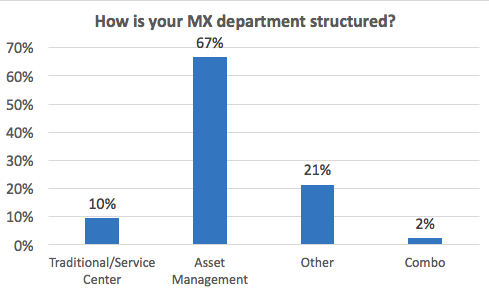 Going back to the survey, 67 percent of those departments make use of an “Asset or Tail Management” model, wherein a maintenance professional is responsible for a specific aircraft.
Going back to the survey, 67 percent of those departments make use of an “Asset or Tail Management” model, wherein a maintenance professional is responsible for a specific aircraft.
About 10 percent use a “Traditional” or “Service Center” model, employing a hierarchical structure with specialized roles in inspection, avionics, maintenance and line service.
The balance of departments operate with a combination of the two models.
7 Questions Re: MX Pro Shortage and Industry Status
In sum, the survey results provide us with a pretty good picture of where we are regarding maintenance professionals in this industry.
Following are seven additional questions we asked:
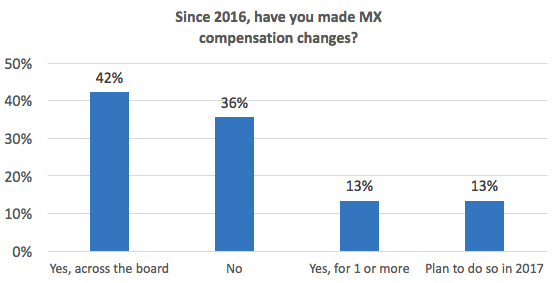 1. Since 2016, have you made compensation changes for your MX pros?
1. Since 2016, have you made compensation changes for your MX pros?
In the past year, 42 percent of respondents have made compensation increases across the board for their maintenance professionals.
Meanwhile, 13 percent have done so for one or more individuals who showed signs that they were leaving.
On the other hand, 36 percent said they have not made any compensation changes, while 13 percent feel that their compensation is at or above industry standards.
Several directors listed in the “no” category have already increased wages to be at or well above the industry, as one noted with this comment: “Compensation is above peer operators; it increases yearly with company and individual performance.”
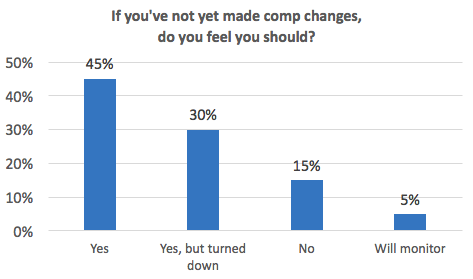 2. If you’ve not yet made compensation changes, do you feel you should?
2. If you’ve not yet made compensation changes, do you feel you should?
Of the 20 department leaders who haven’t raised pay levels in the past year, 45 percent feel they should make changes to pay structures.
Thirty percent have asked management in that regard, but were turned down, while 15 percent do not feel compensation should change.
At least two departments in the “no” category feel this way because they’ve proactively made compensation changes within the past 5 years to be competitive in today’s market (one was between an 11-20 percent increase).
Several leaders noted that they already pay at (or above) the competition.
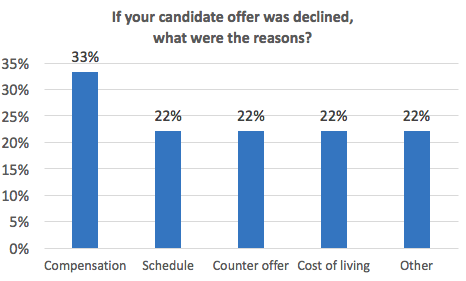 3. If you recently made an offer to a MX candidate who declined your offer, list all reasons that apply.
3. If you recently made an offer to a MX candidate who declined your offer, list all reasons that apply.
Only nine – or 20 percent – of the aviation departments surveyed told us that one of their maintenance candidates recently declined a job offer.
Those nine departments cited 11 reasons for the decline, with the biggest factor related to compensation—but not by much. Other factors included schedule, cost of living and counter offers.
Following are further explanations from respondents:
— “Concerns that the department may downsize due to changing company structure.”
— “Candidate valued frequent flying on the aircraft as a flight tech. We only offer this role on rare occasions.”
— “Didn’t want to work the off shift.”
— “Felt he needed to stay at a service [center] for more experience.”
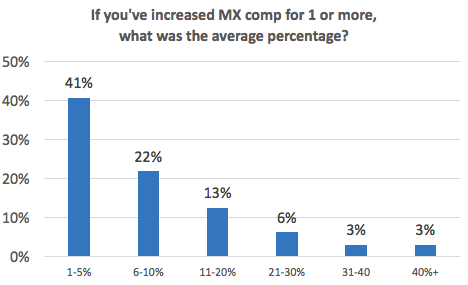 4. If you’ve increased MX compensation for one or more professionals, what was the average percentage?
4. If you’ve increased MX compensation for one or more professionals, what was the average percentage?
Of the 32 flight departments who’ve recently increased compensation for one or more individuals, the majority of them (41 percent) gave their maintenance pros a 1-5 percent increase, which is the average industry wage increase.
Meanwhile, 22 percent gave increases in the 6 to 10-percent range. Thirteen percent increased compensation from 11-20 percent. Two operators gave an increase between 21 and 30 percent and another two flight departments each gave increases that were 31-40 percent and above 40+.
One respondent commented:
“After doing several interviews with other departments, my company took a look at my total compensation and made a significant monetary change (60-70 percent increase) to match the industry. In my opinion, compensation should never be a reason for departments losing talent.”
And another had this to say:
“Yes, we increased compensation for selected individuals. We did this to ensure our compensation was in line with industry, not as a method to keep someone from leaving. We had to onboard a technician and found our compensation needed to be updated if we were going to be competitive in the market.”
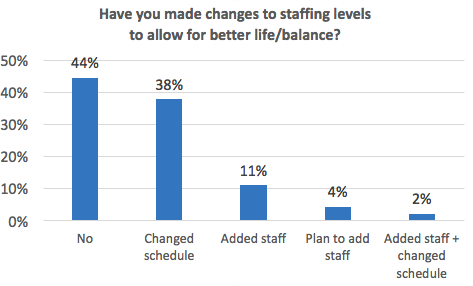 5. Have you made changes to your MX staffing levels to allow for better life balance/schedule?
5. Have you made changes to your MX staffing levels to allow for better life balance/schedule?
Life/balance issues remain a critical factor in achieving or maintaining adequate MX pro staffing levels.
Thirty-eight percent of respondents said that, in response, they changed their employees’ schedules to enable them to better balance their work/life, and 11 percent said that they added headcount to alleviate the issue.
A sizable number, 44 percent, responded that they’ve not made any changes in this regard.
6. How has the maintenance shortage affected your flight department?
Written responses to this survey question offered a clear snapshot of the state of the maintenance professional shortage.
Overall, most of the comments echoed this respondent’s straightforward statement: “Yes, there is a lack of skilled technicians. The technicians that are available have zero to five years of experience, and the pool of technicians with 10-20 years has dried up.”
Here are other perspectives from the respondents:
–“Difficulty finding qualified new hires. Cannot find qualified AMTs to contract if needed. I’ve also noticed a trend at MROs having difficulty retaining talent to work on business jets.”
–“Ten years ago, when we posted an open position for a maintenance technician, we had at least 30 qualified applicants. Today we may receive four or five.”
–“We hired a few years ago, the process took three to four months longer than anyone thought, and we barely had three good candidates to pick from. We ended up with a great guy.”
–“We must be considering the need to establish a ‘pipeline’ of talent, and also understand the need to compensate fairly.”
— “Been trying to locate a part-time maintenance technician for two months—no applications!”
— “We have seen the average age of applicants steadily going up over the last few years. This has a minimal impact but will become an issue once these people leave the workforce.”
7. Have you implemented any unique recruiting strategies that you’d like to share with us?
Responses in this section were plentiful and interesting. Following are a few of them:
— “All of the technicians are treated like family. They have all worked in some of the more challenging aviation areas and appreciate being treated fairly. They regularly comment on that fact. That being said, it does not make up for being paid below corporate survey standards. Add to that a company initiative to not give raises for the next year and keeping technicians may become an issue.”
— “[Our philosophy is] 80 percent hire on personality and cultural fit, 20 percent on job requirements and experience.”
— “We have been able to hire [younger people] from within our company; hopefully, we can train them early in their career.”
— “I’ve only had one opportunity and corporate HR took over. The outcome was positive, the process was not!”
Next Step: Start Now
To summarize the results, yes, there is indeed a maintenance professional shortage, and flight departments will feel it as they try to replace headcount.
So, just what does one do with this information?
- Renew your focus on keeping star players. Several aviation directors sounded off about what it takes to retain top talent in this blog. Among the topics were: providing upfront transparency, cross-training and internal mobility opportunities.
- Talk to your HR partner and make them your ally. Perhaps they are unaware of the shortage and need to be educated so they can help you formulate a recruiting strategy. If you know of upcoming retirements, start mining for talent now within your own department, and, as well, among your network contacts. Help them understand the various sources to find talent. As specialized aviation recruiters, one thing we’ve experienced is that MX professionals tend not to relocate unless they’re at the leadership level. That means departments must find qualified talent locally, which often results in talented prospects being recruited by another Part 91 flight department.
- Start your succession plan, if you haven’t done so already. Don’t wait until a person retires; hire them and then train them on the job (in a job shadow situation). It might take five to eight months to find the right fit, but it will be worth it to get ahead of the process, rather than behind it.
- Try altering the schedule. Since schedule is the number one reason people leave, perhaps adjusting the available work times can help you retain talent and attract up-and-comers with growth opportunities.One department offered this solution:
“We have a pretty nontraditional schedule to help with the work/life balance. We’re a very busy flight department with lots of Friday nights and weekends, along with flying on the airplane. We cover normal business hours 0800 – 1630, and have early hours, flex hours as well as late hours. I also give a day off for weekend work.”
- Network with mid-level professionals to let them know when you’ll be hiring—even if it’s only going to occur within the next few years. Here’s a proactive mindset:
“I’m always looking for prospects or at least have that in the back of my mind when meeting people. I have line-service technician positions that have potential to develop into an A&P position. LinkedIn is a great tool to connect and stay connected with people that you don’t see very often.”
- Talk to technical schools and universities to collaborate on internships. One department leader shared with us this recruiting strategy:
“We offer 12-week internships and a one-week student development opportunity to expose students to business aviation.”
Another director shared this creative solution:
“We identified a college student whom we wish to employ after he gains experience. We negotiated an agreement with a MRO that we will pay for this individual’s maintenance “initial” if they will hire him in an aircraft maintenance role. The understanding is that we will hire him once an opening is available in our department.”
- Get creative with training and outsourcing, as this leader did:
“Because we can’t find available qualified technicians with avionics/connectivity skills, we’ve had to refocus training for technicians with mostly mechanical skills to get them up to speed with the new technology and avionics. Additionally, some avionics work that would have been done in-house is now sent out to MROs.”
- Reach out to us at API to see if you might benefit from specialized recruiting services.
Here at API, we want to provide as many tools as possible to help flight departments be successful. In an upcoming blog, we’ll shed some more light on how we got here, and look at other ways maintenance leaders are creatively solving this talent shortage issue.
Your Turn
Where is your Part 91 department on the aviation maintenance shortage? Are you finding it hard to attract qualified talent that fits within your culture? In either case, we’d like to hear from you.
This article was co-authored by Jennifer Pickerel and Sheryl Barden of Aviation Personnel International.

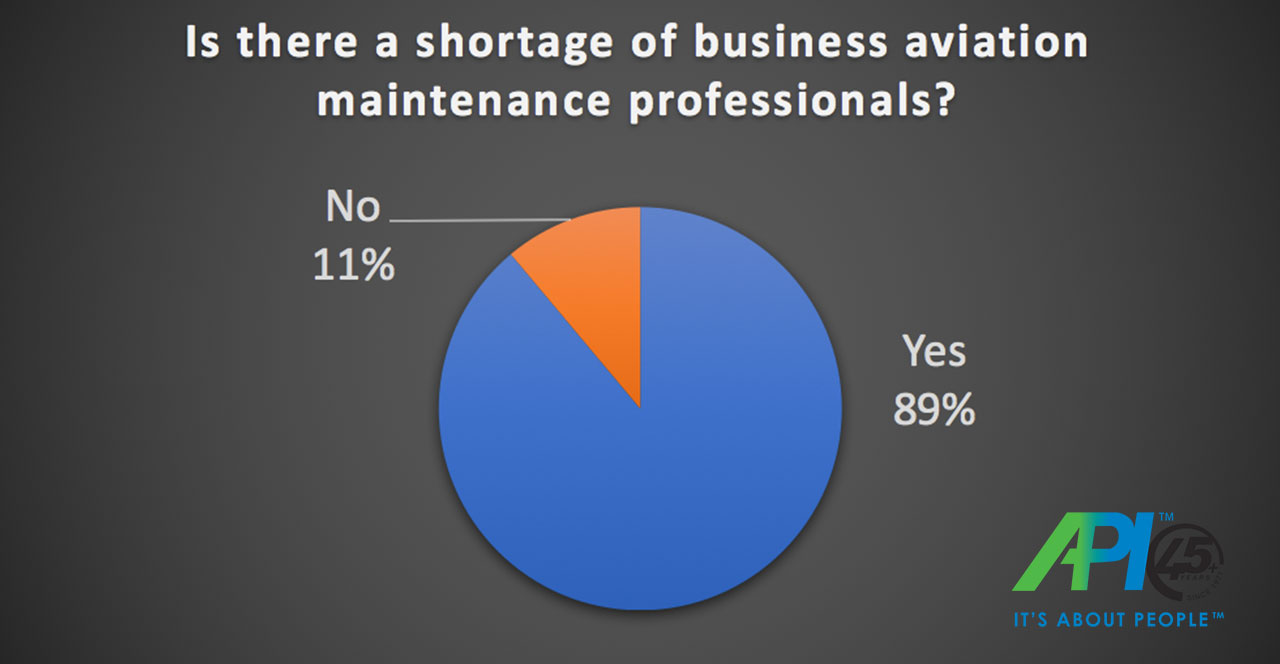
It’s great that you talked about the importance of aircraft maintenance professionals. From my point of view, any machine needs to be maintained to provide a quality performance. Plus, a machine as delicate as an airplane should be properly maintained. I think you did an excellent job explaining why it’s a must to find and keep aircraft maintenance professionals.
Thank you for your thoughtful feedback, Eli!